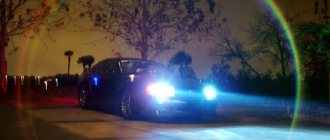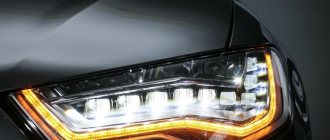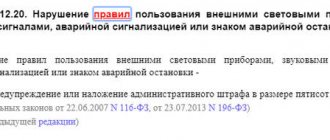Good day to all! Today we will talk to you about halogen lamps for cars. This is a fairly popular and widespread type of lighting device.
Yes, some may say that LED lights are much better and more efficient. I agree. But their installation is not always allowed. Just as xenon headlights are often prohibited. But there are no problems with halogens; most cars come with them from the factory.
But sometimes there is a need to replace halogen lamps, or the car owner wants to abandon the old light based on incandescent lamps, converting the car to more efficient and high-quality solutions. But from September 2021, the use of halogen lamps is prohibited in EU countries. This was done with the aim of developing an energy saving program. The emphasis is now on LED analogues. In our country, no one is refusing halogens yet.
We'll get started, and you can leave your feedback, write comments, and share your personal opinion regarding the use of halogens in vehicle optics.
Responsibility
In answer to this question, I would like to note the following: it just so happens in Russia that the burden of proving guilt no longer lies with traffic police officers in the event of going to court to resolve a controversial situation. From now on, it is you who will have to prove your innocence; the courts, as a rule, have little understanding of all the intricacies of this issue and in most cases take the side of the traffic police officers.
So, what is the fine for xenon in 2021? And are they deprived of their rights for xenon? Illegally installed xenon is a malfunction in which the operation of the vehicle is prohibited.
Light fixtures do not have lenses or use lenses and lamps that do not match the type of light fixture.
Clause 3.4 of Chapter 3 of the List of faults
Driving a car with unauthorized xenon lamps installed in headlights not intended for their installation entails deprivation of the right to drive a car for a period of six months to a year with confiscation of these lamps and devices for their operation (Part 3 of Article 12.5 of the Code of Administrative Offenses of the Russian Federation). Just like that, but there is no fine - you immediately lose your license for xenon.
Driving a vehicle on the front of which are installed lighting devices with red lights or red reflective devices, as well as lighting devices, the color of the lights and the mode of operation of which do not comply with the requirements of the Basic Regulations for the admission of vehicles to operation and the duties of safety officials road traffic (as amended by Federal Law No. 210-FZ of July 24, 2007) entails deprivation of the right to drive vehicles for a period of six months to one year with confiscation of the specified devices and accessories. (Part 3 introduced by Federal Law dated July 22, 2005 N 120-FZ)
Part 3 of Article 12.5 of the Code of Administrative Offenses of the Russian Federation
Devices for operating xenon lamps are devices designed to ensure their functionality (ignition units and other equipment directly servicing the operation of xenon lamps).
Are halogen lamps allowed in headlights?
May 25, 2021
In the era of Zeus and Hercules, every earthly day began with the goddess of the dawn Eos going to heaven. She was carried by two immortal horses - Phaeton and... Lamp. Note that there was definitely no horse named LED on Olympus.
However, humanity has decided to abandon incandescent lamps and gas-discharge analogues in favor of more economical and durable semiconductor light sources.
Today they are installed in the headlights of even relatively inexpensive cars.
Down with the halogens!
At the beginning of their career, automotive LEDs ruined their reputation: the aftermarket was flooded with outright “leftists”.
As a rule, the light source for the head optics was a dozen tiny LEDs shining in different directions—correct light distribution was not worth even dreaming about.
However, the Philips LED headlight soon appeared, in which narrow strips of LEDs exactly corresponded to the location of the filament in a conventional light bulb. And soon many Chinese manufactories began to produce semiconductor light sources of similar design.
In fact, LEDs cannot be installed in headlights homologated for halogens, and we have written about this more than once. But eastern manufacturers stubbornly write H4 or H7 on the packaging of their products! Illegal? Undoubtedly. However, let’s leave the legal side of the issue for now.
Our main task is to test LEDs for professional suitability. For this purpose, we purchased five kits for installation in headlights designed to work with H4 lamps. Please note that all purchased LEDs are capable of operating at voltages of both 12 V and 24 V.
This suggests that they use high-quality power stabilization units - the so-called drivers.
The differences between a lamp trying to be correct (top photo) and a completely unsuitable one: the correct lamp has separate lines of LEDs for high and low beam. These rulers are similar in size and location to the filament coil in a regular lamp. The correct lamp has a screen covering the lower hemisphere of the low beam luminous element. In addition, the correct lamp is equipped with a driver that allows operation at a voltage of 12–24 V, as well as a cooling radiator.
The differences between a lamp trying to be correct (top photo) and a completely unsuitable one: the correct lamp has separate lines of LEDs for high and low beam. These rulers are similar in size and location to the filament coil in a regular lamp. The correct lamp has a screen covering the lower hemisphere of the low beam luminous element. In addition, the correct lamp is equipped with a driver that allows operation at a voltage of 12–24 V, as well as a cooling radiator.
Installing LED headlights: different options
From a legislative point of view, the installation of diode headlights will make a fundamental difference in the following cases:
- Factory installed LED headlights. Certification of lighting equipment is carried out by the manufacturer himself; the buyer does not need to worry about anything.
- Installation of LED headlights that are standardly installed on the vehicle by the manufacturer. Re-registration with the traffic police will be required; approval of the installation is not required.
- Installation of LED headlights when the manufacturer did not provide for this type of headlights. Installation approval and re-registration with the traffic police will be required.
Let's consider the last two options, since the first does not require additional explanation.
Installing LED bulbs in halogen headlights
Let's say you are the owner of a regular car with halogen optics, and you want to install LED lamps instead of halogen ones. Let's consider this situation from the point of view of traffic regulations. As you know, car headlights are always made for a specific type of lamp, and are marked accordingly. For example, if you install a xenon lamp in a headlight designed for halogen lamps, we will get a significant “flare” around the edges - the reflector is designed for an almost point source of light at the desired point, while the xenon lamp is a cylinder filled with luminous gas. Therefore, precise focusing of the light flux does not occur, and such headlights will always blind oncoming drivers and everyone around.
So is it possible to install LED bulbs in halogen headlights?
No, since this leads to the implementation of paragraph 3.1 of the Appendix to the Traffic Regulations “List of faults and conditions under which the operation of vehicles is prohibited”
List of faults, clause 3.1. The number, type, color, location and operating mode of external lighting devices do not meet the requirements of the vehicle design.
The punishment for this violation is provided for in Part 1 of Article 12.5 of the Code of Administrative Offenses:
Code of Administrative Offenses of the Russian Federation, Art. 12.5 h 1 . Driving a vehicle in the presence of malfunctions or conditions under which, in accordance with the Basic Provisions for the admission of vehicles to operation and the duties of officials to ensure road safety, operation of the vehicle is prohibited, with the exception of malfunctions and conditions specified in parts 2 - 7 of this article , - entails a warning or the imposition of an administrative fine in the amount of five hundred rubles.
Thus, the maximum fine for installing LED light bulbs is 500 rubles. How will an inspector check the type of headlights on a car? It’s very simple - according to the factory markings on the headlight glass. We talked more about headlight markings in the article Are xenon lamps allowed?
Is it possible to install LED headlights instead of halogen ones?
If we talk about replacing entire headlights with ones designed for LED lamps, then such a conversion is usually possible. We are talking about the re-equipment of a car, which is carried out in accordance with the Technical Regulations of the Customs Union “On the Safety of Wheeled Vehicles”:
75. Verification of compliance with the requirements for vehicles in operation in the event of changes to their design is carried out in the form of a preliminary technical examination of the design for the possibility of making changes and subsequent verification of the safety of the design and technical inspection of the vehicle with changes made to the design .
During the preliminary technical examination, it is ensured that after changes are made to the design of the vehicle, its compliance with the requirements of these technical regulations that were in force at the time the vehicle was put into circulation will remain. During the safety check of the vehicle design, it is ensured that after changes are made to the design of the vehicle, its safety meets the requirements of these technical regulations.
Headlight bulbs: let there be light!
Headlights don't work? Do you need to change your car headlight bulbs? Let's figure it out.
First, let's look at what types of headlight bulbs there are.
First of all, car lamps can be divided into 2 main types:
Headlights are installed in the front headlights of a car.
Additional light lamps - these include side lights, parking and interior lamps, brake lights.
Each type of lamp has its own designations and connection standards (for example, H1, H3, H4 - designations for lamps containing halogen gases).
Types of lamps in car headlights
Secondly, according to their purpose, the front lamps are divided:
High/low beam bulbs are the main illumination of the road surface in front of the car. They are component headlights that can be switched when necessary to illuminate distant/nearby sections of the road.
Fog lamps - installed in the head optics. The light from the headlights seems to spread along the road, not illuminating the fog in height. Used in severe weather conditions (fog, rain, snowfall). They not only help the driver better navigate the road in bad weather, but also increase the visibility of the vehicle itself for other road users.
Thirdly, division by design:
Automotive incandescent lamps are the oldest type of lamp. One might say outdated.
Halogen (halogen) lamps are an incandescent lamp in the bulb of which there is a buffer gas (halogen vapor - bromine or iodine). They have a long service life. The most common type of lamps used in car headlights. They are constantly being improved to obtain greater light intensity and increase the radius of illumination in front of the car.
Xenon lamps - consist of a bulb with gas (xenon) and electrodes. They glow due to the electric arc that occurs due to the supply of voltage. The light that a xenon lamp emits is white, close in spectrum to daylight, and bright (the intensity is 3 times higher than that of halogen lamps). Bright, energy efficient, and long-lasting lamps. Comfortable for the driver's eyes, but may be excessively bright for other road users.
Light Emitting Diodes - Consists of numerous light emitting diodes (LEDs). The light emitted is close to daylight. They consume less electricity compared to halogen lamps and have a very long service life. Work without wear for a long time of use. Thanks to their small size, they open up wide design possibilities. However, in winter, the luminous flux of LED lamps is significantly reduced.
What you need to know about headlight bulbs before replacing them
1. The basic rule to remember if you are planning on replacing headlight bulbs is that headlight bulbs should be replaced in pairs.
There are good reasons for this:
- The light bulbs were installed together at the same time, which means that once one burned out, the death of the other was not far off.
- If you decide to leave the second one and replace only one in order to save money, then you will disrupt the light distribution picture, because a new lamp will always shine brighter than one that has already worked for a long time.
When can LED headlights be installed?
If LED headlights are installed on a car by the manufacturer, then installation of such headlights can be carried out according to a simplified scheme. No examination will be required to determine whether such a conversion is possible in principle. It will be enough to make a replacement in a workshop certified for such work and register the conversion with the traffic police. This is evidenced by paragraph 77 of section 4 of chapter V of the technical regulations of the customs union:
77. Vehicles are not subject to inspection in the following cases: 1) when installing components on a vehicle: intended for this vehicle and having passed the conformity assessment as part of this vehicle, which is confirmed by the documentation of the component manufacturer; provided by the vehicle manufacturer in the operational documentation; 2) when serial changes are made to the design on the basis of design documentation developed and approved in the prescribed manner, if on its basis an assessment of the conformity of the changes made was carried out.
That is, the checks specified in clause 75 of the Customs Regulations will not be required in this case.
Selecting a shade
Depending on the purpose of the lamp, it is necessary to choose the shade of the glow. The H4 white light halogen bulb can produce warm, cool or neutral beam colors. Warm shades are more often used for all-weather appliances. However, yellowish light can cause driver eye fatigue. Truckers and forwarders purchase devices with a neutral (pure) glow shade for headlights.
To create a car's headlight, devices with a glow temperature of 4600-6000 K are optimally suited. The driver's eyes are less tired. He remains collected and concentrated. The bluish glow improves the appearance of the headlights, bringing them closer to more expensive xenon models. Therefore, many drivers prefer to install these types of lamps in their headlights.
The neutral and cool shade of white glow has one drawback. In fog or rain, the rays reflect from the drops and blind the driver. In such weather, it is preferable to turn on lamps with a warm shade of light.
Is the crossing allowed for fishing?
There was a serious uproar around the article Catching catfish with a line. The popularity is incredible.









